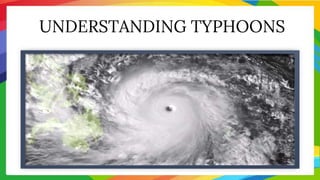
W3 Understanding Typhoons PPT.pptx
- 2. In this lesson, We will be able to understand the Typhoon’s: A. Definition B. Anatomy C. Formation D. Categories We will also find out: A. Why Philippines is prone to typhoon? B. How a typhoon dies? C. What are the Public Storm Warning Signals in the Philippines?
- 3. Trivia Question: We hear weathercasters talk about typhoons, hurricanes and cyclones – which of the following is the true statement? a. Typhoons are bigger than cyclones; cyclones are bigger than hurricanes. b. Hurricanes are stronger than typhoons and cyclones. c. Hurricanes, typhoons and cyclones occur in different geographical areas.
- 4. The correct answer is C. Typhoons, cyclones and hurricanes are the same weather phenomenon – the difference is the geographical area where they occur. They are tropical cyclones with regionally specific names.
- 5. PAG-ASA is the agency responsible for assessing and forecasting weather, flood, and other conditions essential to the safety and welfare of the people. It also conducts research & development projects related to atmospheric and allied data. It now serves as one of the Scientific and Technological Services Institutes of the Department of Science and Technology.
- 6. Did You Know That In 1963 by the Philippine Weather Bureau through the use of four sets of alphabetically arranged Filipino women nicknames ending in “ng” that are alternately used every four years. In 1999, the Philippine Atmospheric, Geophysical and Astronomical Services (PAGASA) held a nationwide search for new generation tropical cyclone names. It was dubbed as “Name the Bagyo Contest.” The result of the search which was picked out from more than 18,000 entries was 140 no- gender-bias names that will be used until 2016 by PAGASA.
- 7. Not so Fun Fact According to the Philippine Atmospheric, Geophysical, and Astronomical Services Administration (PAGASA), about 20 tropical cyclones enter the Philippine Area of Responsibility each year.
- 9. an intense circular storm characterized by low atmospheric pressure, heavy rain and high winds winds in a counter- clockwise direction. (counter-clockwise direction if northern hemisphere and clockwise direction if southern hemisphere)
- 10. What are the parts of typhoon? The main parts of a tropical cyclone are the rainbands, the eye, and the eyewall.
- 13. A typhoon forms when winds blow into areas of the ocean where the water is warm. These winds collect moisture and rise, while colder air moves in below. This creates pressure, which causes the winds to move very quickly. ... In order for a storm to be a typhoon, wind speeds have to reach at least 74 miles per hour.
- 14. The Intertropical Convergence Zone, or ITCZ, is the region that circles the Earth, near the equator, where the trade winds of the Northern and Southern Hemispheres come together. The intense sun and warm water of the equator heats the air in the ITCZ, raising its humidity and making it buoyant. *Southwest monsoon winds and Northeast monsoon winds
- 18. Points Latitude, Longitude A 5oN, 115oE B 15oN, 115oE C 21oN, 120oE D 25oN, 120oE E 25oN, 135oE F 5oN, 135oE Points of Philippine Area of Responsibility
- 19. A. If a typhoon is located at 15oN, 138oE, is it within the PAR? B. How about if the typhoon is at 19oN, 117oE, is it inside the PAR?
- 21. Movement and Speed of Tropical Cyclone Over the Philippine Sea, Tropical Cyclones tend to move on a general west- northwest (WNW) direction with an average speed of 19-20 km/hr. Landfall is the event of a storm moving over land after being over water. More broadly, and in relation to human travel, it refers to 'the first land that is reached or seen at the end of a journey across the sea or through the air, or the fact of arriving there.
- 23. 1. Where did the tropical cyclone form? On land or in the ocean? 2. In what direction did the tropical cyclones move? 3. Which part of the Philippines was hit by the four tropical cyclones?
- 24. PUBLIC STORM WARNING SIGNALS in the Philippines